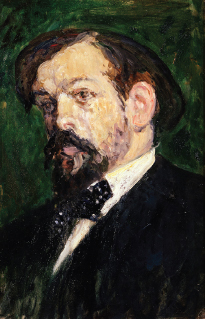Biography
Claude Debussy (1862–1918)

Claude Debussy went through the strict curriculum of the famous Paris Conservatory of Music, which he entered at the age of ten. He did not do well in the piano exams, or at least not well enough, but won various awards in theory and composition. He was finally awarded the coveted Grand Prix (Top Prize) — a three-
Before this, Debussy took a job with Madame von Meck, the eccentric patron of Tchaikovsky, playing in a trio at her house in Moscow. Russian music (see page 284) was one of several vivid influences on the young composer; another was the Indonesian gamelan (see page 198), which he encountered at the world’s fair in Paris in 1889. Visits to Bayreuth, the shrine of Wagner’s music dramas, afforded another, even stronger influence. But Debussy soon turned against Wagner and German music in general.
Debussy settled into Parisian café life, becoming a familiar bearded figure in his broad-
In his early thirties Debussy seems to have rather suddenly crystallized his musical style, reflecting the influences of the French symbolist poets and impressionist painters. One remarkable work after another was given its premiere, greeted with a flurry of controversy, and then generally accepted by the critics and the public. His one opera, Pelléas et Mélisande (1902), was written directly to the words of a play by the prominent symbolist Maurice Maeterlinck. He planned a second opera, on Edgar Allan Poe’s story “The Fall of the House of Usher,” but never finished it.
Debussy is famous for his innovations in orchestration and in piano writing. His Preludes and Études for the piano are the most impressive “miniatures” since the time of the early Romantics; some would say the same for his songs. One of his later works, music for the ballet Jeux (Games), dissolves melody, theme, and rhythm so far that it was taken up as a model by the avant-
For a short time Debussy wrote music criticism, in which he expressed in pungent prose the anti-
Chief Works: For orchestra, Prelude to “The Afternoon of a Faun” (a famous poem by the French symbolist poet Mallarmé); Three Nocturnes; La Mer (The Sea); Ibéria; Jeux (Games) ◼ The opera Pelléas et Mélisande ◼ For piano: Preludes and Études, Children’s Corner Suite, and Suite bergamasque, including “Clair de lune” ◼ Songs to poems by Baudelaire, Verlaine, and Mallarmé ◼ A string quartet and other chamber music ◼ Syrinx for solo flute
Encore: After Clouds, listen to Fêtes (Festivals), Prelude to “The Afternoon of a Faun,” “Clair de lune.”
Image credit: Musée d’Art et d’Histoire, Saint-